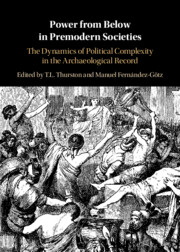 Power from Below in Premodern Societies
Power from Below in Premodern Societies Book contents
- Power from Below in Premodern Societies
- Power from Below in Premodern Societies
- Copyright page
- Contents
- Figures
- Contributors
- Preface
- One Power from Below in the Archaeological Record
- Two Fragmenting Trypillian Megasites
- Three Structure and Agency
- Four Power Requires Others
- Five “And Make Some Other Man Our King”
- Six Societies against the Chief? Re-Examining the Value of “Heterarchy” as a Concept for Studying European Iron Age Societies
- Seven Peasants, Agricultural Intensification, and Collective Action in Premodern States
- Eight The Spread of Scribal Literacy in Han China
- Nine Confronting Leviathan
- Ten The Emergence of Monte Albán
- Eleven Dispersing Power
- Twelve The Perplexing Heterarchical Complexity of New Guinea Fisher-Forager Polities at Contact
- Thirteen Restoring Disorder
- Index
- References
Six - Societies against the Chief? Re-Examining the Value of “Heterarchy” as a Concept for Studying European Iron Age Societies
Published online by Cambridge University Press: 08 October 2021
- Power from Below in Premodern Societies
- Power from Below in Premodern Societies
- Copyright page
- Contents
- Figures
- Contributors
- Preface
- One Power from Below in the Archaeological Record
- Two Fragmenting Trypillian Megasites
- Three Structure and Agency
- Four Power Requires Others
- Five “And Make Some Other Man Our King”
- Six Societies against the Chief? Re-Examining the Value of “Heterarchy” as a Concept for Studying European Iron Age Societies
- Seven Peasants, Agricultural Intensification, and Collective Action in Premodern States
- Eight The Spread of Scribal Literacy in Han China
- Nine Confronting Leviathan
- Ten The Emergence of Monte Albán
- Eleven Dispersing Power
- Twelve The Perplexing Heterarchical Complexity of New Guinea Fisher-Forager Polities at Contact
- Thirteen Restoring Disorder
- Index
- References
Summary
Carole Crumley’s (1979; 1995a; 1995b; 2015) explorations on the applicability of heterarchy as a concept within archaeology have been highly influential in Anglo-American discourse on social organization. Despite largely emerging from Crumley’s work on Iron Age France (Crumley, 1979), however, the relevance of heterarchy as a concept for challenging hierarchical models of European Iron Age societies has largely been restricted to Britain (e.g. Moore, 2007a; Hill, 2011), where evidence for “elites” seems most obviously lacking. Northwestern Iberia has also been a locus for discussion of acephalous and nonhierarchical social forms (Fernández-Posse & Sánchez-Palencia, 1998; González-García et al., 2011; González-Ruibal, 2012; Sastre-Prats, 2011), but one where explicit discussions of heterarchy have rarely featured. More recently, it has been argued that almost all European Iron Age societies can be regarded as “broadly heterarchical” (e.g. Bradley et al., 2015: 260), although the wider implications of this have yet to be explored. What is the place, then, of heterarchy in Iron Age studies? Has it merely become a label for all nonhierarchical models (Fernández-Götz, 2014: 36), creating various Iron Age “societies against the state” (Clastres, 1977), or does it offer ways of exploring not just alternatives to hierarchies but thicker descriptions of how all Iron Age societies worked?
- Type
- Chapter
- Information
- Power from Below in Premodern SocietiesThe Dynamics of Political Complexity in the Archaeological Record, pp. 125 - 156Publisher: Cambridge University PressPrint publication year: 2021
References
- 7
- Cited by


